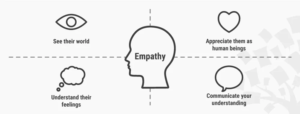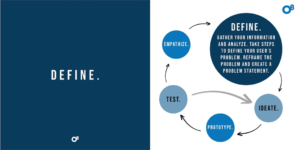So now that you’ve learned the differences and similarities between design thinking and user-centered design. The important takeaway from both weeks 1 and 2 is that no matter your preference of methodology, they both are implemented with the end user in mind.
This week’s focus will be on gaining a deep understanding of your user as well. In addition, painting a clear picture of who your end users are, what challenges they face, and what needs, and expectations must be met.
Emphasize: Getting to know the user
Before we get into it, let’s take another look at the steps of the design thinking process:
- Empathize
- Define
- Ideate
- Prototype
- Test
The first stage is all about getting to know the user and some of the problems they face. This stage requires you to gain a level of understanding of the market, competitors and existing services that are in the industry.
Proper research within this phase is vital because without it, you are left with just guesses and assumptions and, trust me on this, there’s nothing worse than being confidently wrong.

Best practices
- Empathy Map
- Interviews
- Surveys
- Mind Mapping
One tactic that I find useful is a method I like to call “setting the stage” which I can best describe as creating a scenario in which you ask users to describe an instance where they faced the problem you are looking to solve.
If you were following along last week, I used the product that I built, Swipabot, as an example to give perspective on the product lifecycle. I will use it again here. The way we “set the stage” was by asking each user what a typical online shopping experience was like when looking to obtain highly coveted items.
One consistent thing that I’ve found working with other startups and building my own products, is that skipping or not investing adequate time and energy in this phase can be detrimental to your product and your team as you look to deliver solutions. No matter how sure you are of the idea, no one wants to operate under assumptions.
Defining the user’s needs and problem
Now that we’ve taken the time to understand the user and some of their jobs, pains, and gains, this is where we start setting things into stone.
This is the point where we are simply gathering data from the emphasize stage and use that to form your problem statement. This will guide your product vision through the entire design process and beyond.
Best practices
- User Personas
- Value Map
- Value Proposition Canvas

Throughout this phase is where the magic happens and you start to realize your who, what, and how. The best way I can urge you to apply this step is to implement the framework “we do (X), for (Y), by doing (Z).”
Not only does this allow you to concisely explain your company and product’s bottom line, it also allows you to frame the problem in a user-centric way which (you guessed it) is essentially the common theme of this entire product design journey.
Conclusion
When getting to know the user and defining their needs it’s important to take note of the common issues that arise in conversations with the users. After all, empathizing with the user allows you to emotionally put yourself in their shoes, which then plays a huge role into the product design, functionality, and the overall value.
Looking ahead
We’re making progress along our product journey! Now that we’ve learned about the basics of UX, identified the difference between UCD and design thinking, and begun to have a deeper understanding of the user, now it’s time to start ideating.
You know the deal! Catch me this Tuesday on LinkedIn Live at 3pm EST and on Thursday on Twitter Spaces at 7pm EST to talk more about this week’s topic!






